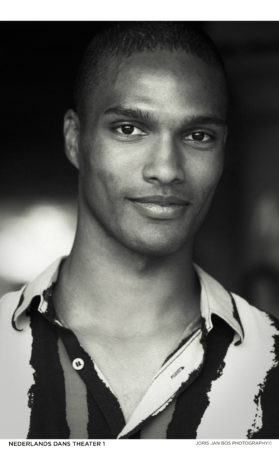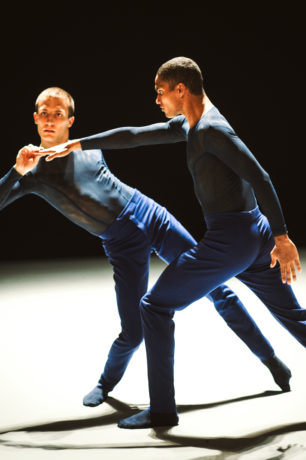Nederlands Dans Theater makes its Kennedy Center debut April 4-6. Artistic director Paul Lightfoot brings a program of distinctive works: “Shoot the Moon” (Glass/León & Lightfoot), “The Statement” (Belton/Pite) and “Singulière Odyssée” (Richter/León & Lightfoot). In each work, progressive ideas are matched by delicacy, intricacy, and virtuosity both onstage and behind the scenes. Recently, I had the pleasure to speak with company dancer Sebastian Haynes, who was able to provide unique insights about this program soon to open at The Kennedy Center.
Jane Franklin: You are a Virginia native?

Sebastian Haynes: I was born right outside DC in Alexandria. My parents and I lived for a couple of years in Alexandria before my mom and I moved to Denmark. My mother is half Danish and half Finnish. My dad is Jamaican living here in America. Most of my life I lived in Denmark, in the countryside. I grew up in smaller towns. The past ten years I spent in the capital of Copenhagen before moving to the Netherlands and The Hague.
About the works on the Kennedy Center program, what is the nature of the collaborative process between choreographer and dancers?
In each case, it’s very different and I think we all want to approach it in that way. Every choreographer is different, every cast of people is different, every time in our lives when something is created is different, and so we always want to take that as a starting point. From there, it can develop in many ways. Some choreographers prefer not knowing what’s going to happen and really dive into a process of discovery and playing around and finding the connections and the juicy stuff to make it happen. Other choreographers have a very clear idea of where they want to go, not necessarily how to get there. Sometimes it’s the other way around. They have a very clear idea how to do something, but where it will take us we will see. The time in the studio is very precious, and it can be really beautiful. It’s the time where we feel the most vulnerable, or open and honest–and really trying to figure stuff out can be very rewarding.
Each of the pieces you’ll perform at the Kennedy Center seem to arise from a unique location- 1) revolving black and white walls; 2) a train station; 3) a conference table. Was it the locations that inspired the development of the choreography?
I wasn’t there for the original creation of any of the pieces, but the “Singulière Odyssée,” which is the one with the train station, is taken from a train station that actually exists. The inspiration came from the passing of time, the passing of people, all of these different destinies crossing each other’s path. The inspiration came from this place that actually exists.
Why is live streaming used in “Shoot the Moon?”
It’s a beautiful effect. We really have to work a lot. My first time doing this piece is on this tour. All the camera work, and being in frame and at the right angle is a new medium for me to a part of and be aware of. It’s very different than being ‘face out’ to the audience. Suddenly there are multiple layers. The audience sees us (live) but also sees us from a different angle, as we are filmed and projected so there are many layers going on at the same time. It’s quite a challenge but really beautiful.
The live streaming is from the wings?
Yes, amazing people are navigating the cameras and moving them around so they will not be seen. The walls keep on moving and turning. There is a lot of choreography backstage with people helping to turn the walls and making sure the cameras are set up correctly.
Is the experience of the camera work to capture minor details like small gestures?
You can really see small details especially when you see the projection and what is happening live, you can understand the experiences from different angles and different mediums. What may come across for you as an audience member seeing the person on stage, versus what comes across on film; it’s very different and really interesting.
Are your roles with the camera operators improvised to some extent?
Everything is very specifically spaced and properly rehearsed so everything is in camera or off camera at the right time. Everything’s very coordinated and rehearsed. It’s a very delicate joining of time.
“The Statement” uses prerecorded dialogue from a play by Jonathan Young. Did the movement develop from the text? Were those words used to actually make the movement?
I’m not in the cast of the piece. But I see what my wonderful colleagues do with their performance. The choreography is very much linked to the text. You see these four people having a discussion, argument, and really interesting conversation. Hearing the words and seeing the movement in close relationship is quite a new experience, or at least a different experience and I think it takes the audience by surprise. Sometimes there are a lot of gasps or laughing because it’s really translatable what is being said and what is being danced.
Do you consistently dance the same role or do you do multiple roles?

We always change very much. For this tour, we have a first and a second cast for both “Shoot the Moon” and “The Statement.” We are very used to changing styles, different choreographers; we really get challenged in this way. It’s quite an opportunity always to see how far you can extend yourself and how far you change yourself. We did a piece called “The Hole” by Ohad Naharin of Israel. We were all challenged by his new style and were really doing our best to get the most out of the experience as possible.
An interdisciplinary approach was mentioned as a hallmark of the company. What is expected of you as artists as you explore the visual art and sets?
We help each other a lot. In one piece there are hidden trap doors and doors that open and close. It’s always very much us (the cast) helping each other, and knowing exactly what is going to happen and knowing each other’s needs and when to open the door and close the door, and when do you hold a colleague before he runs too fast out of the way. We help each other quite a lot. It’s part of the full experience and part of the choreography backstage.
When you are first working with a set, is there any improvisation that comes into play in maneuvering around the sets?
Yes, it takes some time. It’s important to work with the set. It can be quite tricky and intricate. You need to know exactly what’s happening, not just what you are dancing. You need to know what the other dancers need and what you need to do to fit into the whole framework.
Nederlands Dans Theater plays April 4-6, 2018, at The John F. Kennedy Center for the Performing Arts, 2700 F Street, NW in Washington, DC. For tickets, visit the box office or purchase them online




